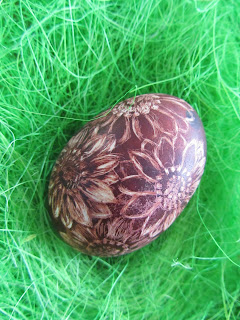




.
The Artistic Side of Easter
The most elaborate Easter egg traditions originated in Eastern Europe. In Poland and the Ukraine, eggs were often painted silver and gold. Decorated eggs are fun to do and creative. My favorite are the scratch eggs, dryapanky, died with onion skins and scratched with an exacto knife, the only limit is your imagination. These can be taken anywhere and worked on at your leisure.
Pysanka is a wax method usually using traditional designs. You design your egg, cover with wax those areas to remain white, then dye the egg, cover those areas to remain the next color with wax and die, the egg to the next color. These originated in the Ukraine and are time consuming to make but beautiful.
Wikopedia lists several other types of egg decorating from the Ukraine—Enjoy!!
Krashanky –from krasyty (красити), "to decorate"– are boiled eggs dyed a single color (with vegetable dyes), and are blessed and eaten at Easter.
Pysanky –from pysaty (писати), "to write"– are raw eggs created with the wax-resist method (batik). The designs are "written" in hot wax with a stylus or a pin-head. Wooden eggs and beaded eggs are often referred to as "pysanky" because they mimic the decorative style of pysanky in a different medium.
Krapanky –from krapka (крапка), "a dot"– are raw eggs decorated using the wax-resist method, but with only dots as ornamentation (no symbols or other drawings). They are traditionally created by dripping molten wax from a beeswax candle onto an egg.
Dryapanky –from dryapaty (дряпати), "to scratch"– are created by scratching the surface of a dyed egg to reveal the white shell below.
Malyovanky –from malyuvaty (малювати), "to paint"– are created by painting a design with a brush using oil or water color paints. It is sometimes used to refer to coloring (e.g. with a marker) on an egg.
Nakelyanky –from kleyaty (клеяти), "to glue on"– are created by glueing objects to the surface of an egg.
Travlenky –from travlenya (травлення), “etching” – are created by waxing eggs and then etching away the unwaxed areas. This is not a traditional Ukraine practice, but has become popularized recently.
Biserky –from biser (бісер), "beads"– are created by coating an egg with beeswax, and then embedding beads into the wax to create geometric designs.
Lystovky –from lystya (листя), "leaves"– are created by dyeing an egg to which small leaves have been attached.
All but the krashanky and lystovky are usually meant to be decorative (as opposed to edible), and the egg yolk and white are either allowed to dry up over time, or removed by blowing them out through a small hole in the egg.
A Little History
Eggs were forbidden during Lent in Medieval Europe. People therefore, preserved the eggs by boiling them and celebrated with them when Easter arrived, giving them as Easter gifts for children. Many ancient cultures included eggs in their spring festivals as a symbol of fertility. Many traditions include Easter eggs including the coloring of eggs and the Easter egg hunt or the egg roll where children roll the eggs down the hill. The White House Easter festival with eggs is among the most well known.
No comments:
Post a Comment